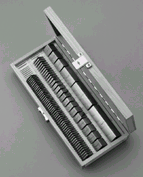![]()
![]()
![]()
![]()
![]()
![]()
![]()
![]()
![]()
![]()
![]()
![]()
![]()
![]()
![]()
![]()
![]()
![]()
![]()
![]()
![]()
![]()
![]()
![]()
![]()

|
Cleanliness
is critical. by Drew Koppelmann |
Gage blocks -- those apparently simple little chunks of steel that are used to establish an accurate size reference for comparative gages -- are among the most accurate gages to be found anywhere. Often manufactured to tolerances ±2 microinches for sizes under 1" (or ±0.05 micrometers for sizes 10mm or less), gage blocks form the basis for almost all other high-accuracy dimensional measurements that occur in most shops. As such, they're also among the most important of your gages, and they deserve careful attention to keep them in top condition.
Cleanliness is critical. Gage blocks must be stored clean and must be recleaned immediately prior to use. Any concentration of dust -- even the amount that occurs naturally over the course of an hour -- will reduce their accuracy. When wringing two or more blocks together to build up a stack to the required nominal dimension, any dust, dirt or grit on the surface of one will tend to score the other and will reduce the accuracy of the stack. And don't even think about using a block that has been splashed with cutting fluid -- you know what the suspended metal particles will do to that mirror-smooth surface.
To clean a gage block, use filtered kerosene, a commercial gage block cleaner or other high-grade solvent. Wipe it dry with a lint-free tissue, not some shop rag or work apron. Don't clean blocks by rubbing them against your palm; even if your hands are clean, you'll transfer moisture that could promote corrosion. In fact, it's a good idea to wear white gloves or rubber fingertip covers when wringing blocks and to handle them with tweezers when returning them to their case after cleaning. To inhibit corrosion from ambient humidity while the blocks are in storage, coat them with a noncorrosive oil, grease or commercial gage block preservative.
Sets of gage blocks are sold in a nice fitted case, which should be considered an integral part of the gage block system. Keep the interior clean, and keep it closed when you're not actually removing or replacing blocks. Don't just toss blocks into the case (and certainly not anywhere else); they'll get scratched and nicked before you know it. Return each to its proper slot as soon as possible. You'll be able to immediately see which blocks are in use, and you'll find the ones you want quicker. Keep the exterior of the case clean, too; it's a clear indication to others that the set should be treated with care and respect.
Don't loan out individual blocks -- keep the set complete. As soon as a block leaves its set, you've lost control over how it will be treated, and it may be returned damaged -- if at all. Inspect blocks frequently for nicks, scratches or burrs. If any such flaws appear, replace or have the block repaired immediately. A block with a burr or a corroded surface will quickly damage any other block it is wrung to.
Do not allow stacks of gage blocks to remain wrung together for long periods. The physics that hold wrung blocks together is not well understood, but experience has shown that failure to separate blocks may result in them becoming permanently fused to one another. Even if you use the same set-up day after day, it's good policy to separate and wring them daily.
Many users compile gage blocks backwards when building up a stack, starting with the largest possible block and working their way down to the last decimal place. This can be quite inefficient and often results in stacks that are five or more blocks high. It's smarter to start small and work your way up. For any nominal dimension under 5", you'll never need to combine more than four blocks, or more than one from each of the four series in the set. Furthermore, the fewer the number of wrings, the smaller the accumulated error in the stack.
As an example, let's use a nominal dimension of 1.3248". We work by creating zeros, starting from the right. To create a zero in the 10-thousandths place, we have only one choice in the series of 10ths blocks: the 0.1008" block. Select that block, subtract it from the nominal dimension, and we've created our first zero. We're down to 1.2240".
We have three choices in the second series of blocks, to turn the thousandths place into our next zero: 0.104", 0.114" and 0.124". We'll take the last one and kill two zeros with one stone. Subtract 0.124" from 1.2240", and we're down to 1.1000". Now it's easy. Pick the 0.1000" block and, last, the 1.0000" block. Four blocks, requiring just three wrings, and we're done. But don't forget to clean them first.
About the author
As applications manager, gaging products, at Federal Products Co. in Providence, Rhode Island, Drew Koppelmann provides dimensional gaging applications assistance to companies in a wide range of industries, including automotive, aerospace, packaging and electronics. He may be reached by fax at (401) 784-3246.


|
[Homepage] |
|
[About Us] |
Copyright 1997 QCI International. All rights reserved. Quality Digest can be reached by phone at (916) 893-4095.
Please contact our Webmaster with questions or comments.